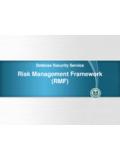Transcription of FRAMEWORK FOR ASSESSING - OECD.org
1 1 POLICY FRAMEWORK FOR POLICY COHERENCE FOR DEVELOPMENT Working Paper no 1, 2012 OECD Office of the Secretary-General Unit for Policy Coherence for Development Contact: Ms. Ebba Dohlman, tel. +33 (0)1 45 24 98 48, email: 2 TABLE OF CONTENTS PREAMBLE 2 I. INSTITUTIONS 5 Political commitments and policy statements 6 Policy coordination and mechanisms 7 Systems for monitoring, analysis and reporting 8 II. AGRICULTURE 10 Domestic policies 10 Trade 11 Regulation 12 Development cooperation 13 III. FISHERIES 15 Domestic policies 16 Trade 17 Regulation 18 Development cooperation 19 IV. ENVIRONMENT 21 Climate change 21 Protection of natural resources 23 Trade and regulation 24 Development cooperation 25 V.
2 METHODOLOGY FOR PCD ASSESSMENT 26 General FRAMEWORK for ASSESSING PCD progress 27 Success criteria for PCD 27 Methods and conditions to improve PCD 29 Methods and conditions to assess the progress of PCD 30 PCD assessment in three stages 30 Baseline assessment 30 Prospective evaluation 31 Retrospective evaluation 32 Existing assessment tools 38 ASSESSING policy interactions 42 BIBLIOGRAPHY 44 3 PREAMBLE What is PCD? Contributing to global development is a key objective of the OECD and its member states. Improving effectiveness and quality of aid remains critical to foster development in developing countries; aid acts as a safety net and can have a catalytic role on growth. Aid is a necessary but not sufficient driver of development. The profound impact of multiple and interrelated global crises (financial, economic, food and energy) on the world s poorest and the increased countries interdependency, meaning that the impacts of policies put in place by any one country are felt far beyond that country s borders, demonstrate the need for the development community to go beyond aid.
3 We need to work with other policy communities in a wide range of policy areas beyond aid - including taxation, trade and investment, agriculture and food security, education and skills development, etc - to ensure that these policies also contribute to development. For example, the impact of agricultural subsidies on world prices and the high tariff barriers in place in OECD countries limit developing countries ability to benefit from exporting agricultural produce, thereby undermining their development prospects. The need to accelerate progress towards the MDGs has made our development work and objectives even more vital in supporting the global community to achieve sustainable development. The concept of policy coherence for development (PCD) aims to exploit positive synergies and spillovers across public policies to foster development.
4 A meaningful working definition of PCD goes well beyond minimizing the adverse impact that public policies can have in developing countries; it entails the systematic application of mutually reinforcing policies and integration of development concerns across government departments to achieve development goals along with national policy objectives. According to the DAC Journal of Development Co-operation,1 Policy coherence means different policy communities working together in ways that result in more powerful tools and products for all concerned. It means looking for synergies and complementarities and filling gaps among different policy areas so as to meet common and shared objectives. The work on policy coherence can lead to raise questions such as: Do our trade policies reinforce our development co-operation policies, or do they work at cross purposes?
5 , Do our migration policies, such as in the health care sector, potentially undermine prospects to achieve health-related MDGs in sending countries? , or How can we promote economic growth at the same time as environmental sustainability in the developing world? PCD is not just an abstract concept, but an objective that can be achieved through practical measures. PCD can be implemented at different levels: internally within the development cooperation, within the country (coherence between national aid and non-aid policies), between donors, and at the partner country s level. The OECD assists governments in achieving policy coherence through the development of guidelines on political and administrative structures and processes to foster an effective and harmonised policy-making process. A whole of government approach is valuable to better understand potential impacts of domestic policies on development and to effectively implement PCD.
6 PCD also requires the development dimension to be given adequate weight throughout and at every stage of the policy design and reform across the government. Addressing PCD will not only increase the scope to leverage ODA more effectively and boost the political relevance of aid policy, it will also result in more efficient policies and thereby a better use of public money to the benefit of all citizens. For example, providing financial aid to developing countries while allowing the existence of tax heavens leads to an inefficient use of public money. Tax heavens result in a loss of almost three times what developing countries get in aid; if taxes on this income were collected, billions of dollars would become available to finance development, reducing the cost of aid for developed countries. 4 The challenge of PCD The concept of PCD is still not sufficiently understood in many countries, particularly outside of the development policy communities, which can result in a lack of political interest and will to implement PCD.
7 Governments pursue a wide range of policy objectives, trying to balance interests and priorities of domestic constituencies with longer term foreign and development policy objectives. These may, in the short term, appear to be competing or even contradictory objectives. But in an increasingly interconnected world, neglecting development may undermine the achievement of domestic objectives. National security, for example, can be enhanced by fostering development in fragile states to strengthen their capacities to fight terrorism or trade of illicit products. Evidence-based PCD is critical to foster political support. In an increasingly complex world, the links between policy levers and policy impacts are unclear and thus challenge the reliability of evidence about how best to achieve results.
8 However, the importance of PCD and its role in more efficient use of public money should be widely communicated to the global public and in governance fora to enable political debate and momentum. PCD can only be achieved as a collective effort and through an open and inclusive FRAMEWORK , based on the active involvement of emerging economies, developing countries and international organisations. Greater balance in the global governance architecture could be critical to achieve an effective PCD. The eight Millennium Development Goals (MDGs) relate to PCD but two of them more closely: Goal 1 on poverty reduction and Goal 8 on the development of a global partnership. The reduction of poverty and inequality within developing countries is likely to be associated with progress with respect to many of the other MDGs, while the development of a global partnership depends on actions taken within both OECD countries and developing countries.
9 OECD s work on PCD The OECD is well placed to bring together policy-makers from all public policy areas with development experts and analysts to promote greater coherence. Since the early 1990s, the OECD has played a pivotal role in promoting PCD. OECD s work on PCD was mandated at the 2002 OECD Ministerial Council Meeting as part of the OECD Action for a Shared Development Agenda . The OECD published in 2005 Policy Coherence for Development Promoting institutional good practice ,2 and Fostering Development in a Global Economy - A Whole of Government Perspective .3 OECD Ministers renewed their commitment to PCD in June 2008 by issuing the Ministerial Declaration on PCD4 in which they encourage continuing best practices and guidance on PCD promotion and improved methods of assessment of results achieved.
10 The OECD promotes PCD at four complementary levels: 1) Whole-of-government: The OECD identified building blocks ( Building Blocks for PCD )5 to guide OECD countries in implementing PCD6 based on the lessons learned from DAC peer reviews.. These reviews provided the basis for a good practice guidance endorsed by the Council in April 2010 as Council Recommendation on Good Institutional Practices in promoting PCD. 7 2) Analytical: The OECD has also developed analyses and case studies on the potential or actual impacts of policies on development in a range of areas - including macroeconomic policies, ICTs, Internet, innovation, environment, agriculture, fisheries, health, trade, aid for trade, human rights, tax, and 3) Assessment methodologies: This Policy FRAMEWORK for PCD has been developed to guide policy makers in implementing PCD, with a view to broadening and deepening it.















